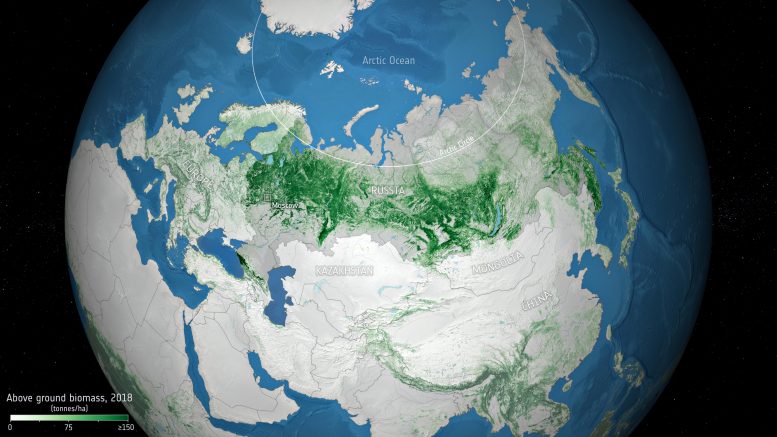
This map shows the above ground biomass in Russia, using data generated by ESA’s Climate Change Initiative (CCI) Biomass project. Credit: ESA (data source: CCI Biomass project)
Russia has the largest area of forest on the planet, with more than a fifth of the world’s trees. A new study, led by Russian scientists using data from ESA’s Climate Change Initiative, has produced new estimates of biomass contained in Russian forests, and confirms that the vast forested area is storing more carbon than previously estimated.
The study, published last month in Nature Scientific Reports, estimates that Russian forests contain 111 billion cubic meters (~3.9 trillion cubic feet) of wood as of 2014 – which equates to 39% higher than the value reported to the Food and Agriculture Organization of the United Nations (FAO) and the United Nations Framework Convention on Climate Change (UNFCCC).
The study uses satellite-based maps of forest biomass, produced by ESA’s Climate Change Initiative (CCI) Biomass project, combined with Russian ground-based measurements, such as data from the National Forest Inventory and the ESA-supported Forest Observation System, to obtain more accurate figures of carbon stored in forests.
Remote-sensing studies have already indicated increases in vegetation productivity and tree cover over the past decades. Yet Russia has reported almost no change in growing stock (+ 1.8%) and biomass (+ 0.6%) since the collapse of the Soviet Union and transition to a new forest inventory system.
This new estimate is in line with the results from the National Forest Inventory, but expands its capacity in terms of spatial and temporal representation. It is expected to have a major impact on how Russia reports its forest carbon stock.
“The paper demonstrates that the current methodology for UNFCCC reporting needs updating. The method of using satellite-based data that is validated with ground-based measurements is best-placed to help with this,” says the study’s lead author Dmitry Schepaschenko, a researcher with the International Institute for Applied Systems Analysis in Austria (IIASA).
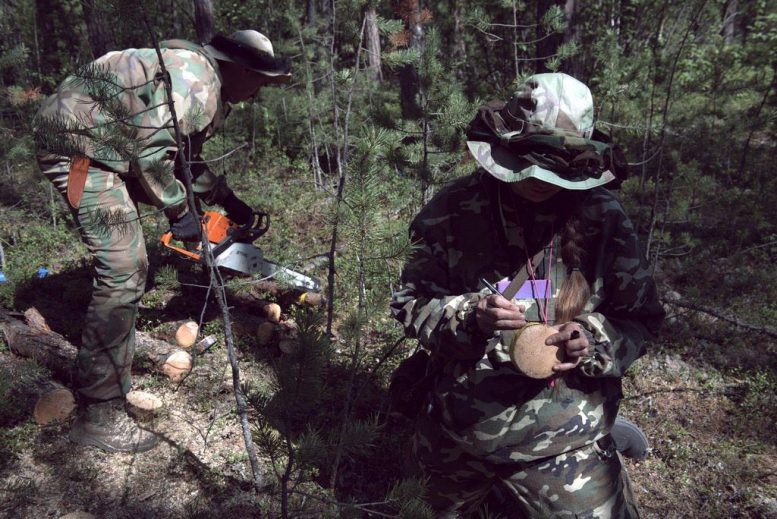
The team collecting samples of dead wood to quantify the carbon pool and associated fluxes. Credit: WRan Kong
“Ground surveying is crucial in measuring biomass. However, the first forest national inventory cycle took 14 years in a country that’s as large as Russia, and is expected to provide a robust estimate at a national scale only. The combination of ground and space-based data has allowed us to provide the results for specific years in a higher spatial resolution and reduce uncertainties of the estimates.”
He continues: “Our team include representatives of Russian academic institutes, people from the National Forest Inventory and Forestry Agency – which ensures the impact on national policy.”
The authors use the last Soviet Union report as a reference, and they found that Russian forests accumulated 1 billion cubic meters per year between 1988–2014, which balances the net forest stock losses reported in tropical countries.
The team found that the sequestered carbon over the same period was 47% higher than that reported in Russia’s UNFCCC National Greenhouse Gases Inventory.
But they warn that the forest gains won’t necessarily continue in the long-term: “Whilst we found that Russian forests have been a more important carbon stock than previously thought, the situation is changing after 2014 because of the increasing severity of forest disturbances,” says Schepaschenko.
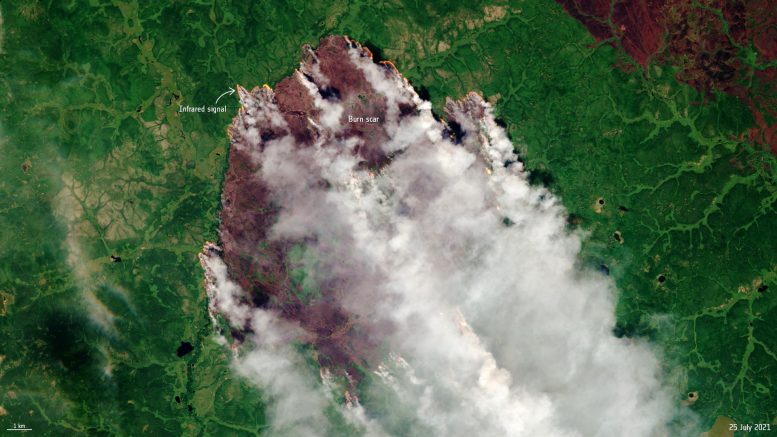
This image captured by the Copernicus Sentinel-2 mission shows one of the many forest fires in the Sakha Republic, Siberia, on July 25, 2021. The image has been processed using the mission’s shortwave-infrared band to identify the active fires. Large clouds of smoke can be seen blowing in a southeast direction, while burn scars are visible in dark brown. Credit: Contains modified Copernicus Sentinel data (2021), processed by ESA, CC BY-SA 3.0 IGO
Forest disturbances can include forest fires, including those currently taking place in the Sakha-Yakutia region of Siberia, which have burned through 1.5 million hectares of land. The fires have shrouded Yakutia’s cities and towns in thick smoke, suspending all flights at the regional capital’s airport. In response to the wildfire, the International Charter Space and Major Disasters has been activated.
The new national estimate and uncertainty make an important contribution to improving ESA’s maps of above ground biomass stored by forests on a global scale via ESA’s Climate Change Initiative Biomass project. The authors’ ground-based measurements will also help validate new satellite observations of biomass that will be provided by ESA’s upcoming Biomass mission.
Reference: “Russian forest sequesters substantially more carbon than previously reported” by Dmitry Schepaschenko, Elena Moltchanova, Stanislav Fedorov, Victor Karminov, Petr Ontikov, Maurizio Santoro, Linda See, Vladimir Kositsyn, Anatoly Shvidenko, Anna Romanovskaya, Vladimir Korotkov, Myroslava Lesiv, Sergey Bartalev, Steffen Fritz, Maria Shchepashchenko and Florian Kraxner, 17 June 2021, Scientific Reports.
DOI: 10.1038/s41598-021-92152-9


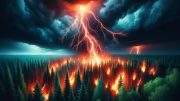

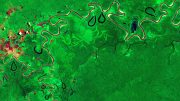



Be the first to comment on "Russia’s Forests Store More Carbon Than Previously Thought – Estimated 3.9 Trillion Cubic Feet of Wood"